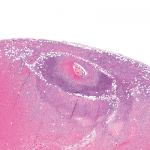
Lightspring / shutterstock.com
Patients with polymyalgia rheumatica (PMR) or peripheral arthritis may require extra vigilance during treatment because of a suspected link to giant cell arteritis (GCA) and, potentially, permanent vision loss. “Development of giant cell arteritis after treating polymyalgia or peripheral arthritis: a retrospective case-control study,” a March 2018 study published in The Journal of Rheumatology, suggests rheumatologists should be on the lookout for cranial signs and symptoms in patients with PMR or peripheral arthritis because these can portend more serious outcomes related to the development of GCA.
Rationale
The frequency of late GCA following a diagnosis of PMR is controversial. This study examined the development of GCA in patients who were previously diagnosed with isolated PMR or peripheral arthritis. Lead author Eric Liozon, MD, Department of Internal Medicine, University Hospital of Limoges, France, and his colleagues sought to define risk factors for late GCA development after pure PMR diagnosis and the principal characteristics of the condition.
“As hospital-based internists involved in the clinical management of PMR and GCA patients, as well as in clinical research on GCA, Hubert de Boysson, MD, MSc, from Caen’s University Hospital [Caen, France], and I have repeatedly observed cases of true PMR evolving into GCA, even after years of follow-up,” Dr. Liozon says. “Two recent studies from Spanish researchers emphasized the ischemic visual risk of GCA occurring in patients with established PMR. However, [neither] of these studies was case controlled. Thus, we were interested in verifying these findings in a case-controlled study and [searching] for other relevant characteristics, both at the initial phase of PMR and at late-onset of vasculitis.”
Study Methods & Results
Researchers retrospectively compared clinical, laboratory and pathological characteristics of 67 patients at the onset of PMR or peripheral arthritis, and their treatments and outcomes, to those of a random group of 65 patients with PMR or peripheral arthritis who did not develop late GCA. Researchers included patients with prior peripheral arthritis (isolated or with PMR) because peripheral arthritis is frequently associated with PMR and may sometimes form part of the rheumatic spectrum of GCA. Researchers also compared the characteristics and outcomes of patients with late GCA with those of a random sample of patients with more usual GCA (65 with concurrent PMR or peripheral arthritis and 65 without). The entire cohort of 132 patients with PMR or peripheral arthritis (67 late GCA patients and 65 controls) was followed for an average of 38.5 months.


